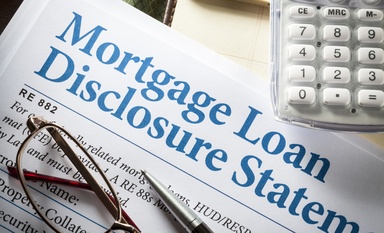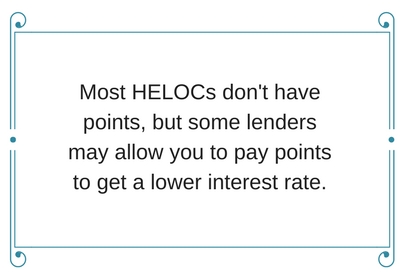 Loan interest rates were explained in HSH.com's previous article. This page outlines fees that may apply to home equity loans and home equity lines of credit (HELOCs) and looks at the tax implications of using your home equity.
Loan interest rates were explained in HSH.com's previous article. This page outlines fees that may apply to home equity loans and home equity lines of credit (HELOCs) and looks at the tax implications of using your home equity.
Home equity loan and HELOC fees and charges
Since a home equity loan or line of credit is a kind of second mortgage, you can expect to pay a number of fees similar to those you paid when you got your first mortgage. However, any percentage-based fees will likely be lower since the loan amounts on second liens are usually smaller than for first mortgages.
Common home equity borrowing fees
Here are some common fees may be charged when you tap into your home equity using a loan or home equity line of credit:
1. Points. Loans, like the old fixed-rate second mortgage, may charge points. Each point, equal to one percent of the loan amount, can easily add up to hundreds or thousands of dollars, depending upon how much you borrow. As noted, most HELOCs don't have points, but some lenders may allow you to pay points to get a lower interest rate.
If available, paying points can make sense in certain circumstances. If, for example, you are taking out a large line of credit that will take years to pay back, you might wish to consider paying those points to get that lower interest rate. Over time, your lower interest rate (and lower monthly payments) should offset the cost of the points. Paying points on a small line, or one you're planning to pay back fairly quickly, may not save any money in the long run.

Keep in mind that while you may only want to borrow a small amount, the lender will often charge points on the maximum line you can ever borrow. If you want to borrow $25,000, for example, but your maximum possible line is $80,000, you are likely to be charged points on $80,000 -- even though you may not borrow all that money. Consider the following, based on a 25-year term, where you pay two points to get the lower interest rate:
Prime + 0.00% = 4.50%; monthly payment is $135; points = $1,600
Versus paying no points, with a higher interest rate:
Prime + 1.65% = 6.15%; monthly payment is $160; points = $0
With a $25 difference in the monthly payment, you have covered the cost of points in about five years, and will begin to save money thereafter. This example assumes that the rates never change; they will, but the relative savings should be equal. This holds true for a smaller line; however, it increases the amount of out-of-pocket expense for a minimal savings in the monthly payment -- about $20 per month on a $20,000 line.
2. Appraisal. Most lenders require some sort of property appraisal to determine just how much the home is worth. Some lenders, particularly in those areas of the country where property values haven't changed much, may require only a 'drive-by' appraisal -- just a quick look at the property's exterior condition and the neighborhood it's situated in. Increasingly, lenders are using "automated valuation models" (AVMs) to determine a working value for your home and only require an actual appraisal if you're looking to tap a lot of equity. In some areas, however, lenders require a full appraisal, done by a professional appraisal firm. While drive-by appraisals and AVM values usually have no costs passed along to you, a full appraisal can cost around $300 or more.
3. Credit check. Another fee to expect is for a credit check; usually $30 to $50. As with first mortgages, your credit score is used to determine what rates and fees can be offered to you, if any. The credit score is usually pulled from one (or more) of the major credit reporting agencies, such as FICO or VantageScore, but lenders may use other models from Experian, TransUnion or Equifax or even their own model. Regardless of the model employed, these are used to judge your past history of handling credit and your willingness to repay. Unfavorable marks or lower scores shouldn't be a roadblock to getting your home equity loan or line, since you are pledging a security -- your home -- against your ability to repay, but they may result in a higher rate, higher fees, lower loan amount, shorter term or some combination of these.
4. Annual fees. Generally, you'll pay annual fees for the privilege of having a line of credit; done as a lump-sum disbursement, home equity loans don't charge annual fees. Some lenders won't charge an annual fee on the HELOC per se, but may change you a "non-usage" fee once per year if you haven't used your line of credit (or haven't borrowed a certain amount of money using it) over a 12-month period. Like your credit card, and whether directly stated or passed along in the form of non-usage fees, an annual fee will cost anywhere from $30 to $75, due on the anniversary of your line each year, but not normally the first year.
5. Recording fees. Also called document stamp fees, county fees and other names, recording fees are a charge levied by the county or parish you live in. Typically $15 to $50, they cover the cost(s) of recording the new lien against your home with the local taxing authority.
Other charges, depending upon local custom, may come into play. However, you should be aware that there is good news regarding fees. Due to the very competitive marketplace for HELOCs, lenders often waive certain fees, or cover the cost of them for you. For loans, however, very few lenders are promoting them this way. So, while it's likely you can get a line of credit with little out-of-pocket expense, your home equity loan may cost at least a few dollars to obtain. Which leads us to...
6. Early-termination fees. Some lenders will waive the actual loan closing costs on their HELOC or pay them for you. so you'll spend little or even nothing out of pocket to take out a HELOC from them. However, this doesn't mean that you might not have to pay these closing costs at some point. In many cases where lenders pay most or all of the up-front fees to close your HELOC, the HELOC contract will contain a contract clause that allows the lender to charge you the actual closing costs they covered if you should terminate your line of credit within the first few years. These can be "conditional"; that is, such a clause might only be triggered if you should refinance your first mortgage and pay off your HELOC within that time. However, others may apply even if you sell your home. If you think these or other conditions might apply to you, you'll want to ask your lender about early-termination clauses and fees and read the fine print in the loan contract or disclosure to understand what might trigger these costs to you.
7. Real estate taxes. Some areas of the country have real estate taxes of anywhere between 1% to 3% of your loan amount that you'll be required to pay at closing. Ask the lender or call the local taxing authority for details.
Income taxes and your home equity loan or line of credit
Determining the tax deductibility of interest you paid on a home equity loan or line of credit used to be simple, as the interest paid on up to $100,000 was deductible regardless of what the funds were used for. However, that came to an end with the 2017 tax year.
Starting with the 2018 tax year, only interest paid on home equity loans or lines that is used to "buy, build or substantially improve" a qualifying first or second home are deductible as a portion of "home acquisition" debt. These changes were made as part of the "Tax Cut and Jobs Act" of 2017.
Under the TCJA, all home equity debt is non-deductible unless it meets the "buy, build or substantially improve" qualification, even if you had the home equity loan or HELOC before December 15, 2017. Interest paid for any other uses was excluded from deductibility after that date.
The TCJA also lowered the total amount of mortgage debt where interest is eligible to be deducted. The mortgage interest deduction applies only to primary and secondary residences and uses the total of loans against both properties, if you have more than one.
For homes with mortgages originated before December 14, 2017, mortgage interest is deductible for total loan amounts up to $1,000,000 ($500,000 if married but filing separately). For mortgages after this date, the mortgage limits are reduced to $750,000 and $375,000 respectively. The $1,000,000 / $500,000 limit is "grandfathered"; that is, if you originally financed your home before December 14, 2017, you get to continue to use the higher dollar amount for your deduction, even if you refinanced after that date. However, someone who bought after the 12/14/17 deadline is subject to the new and lower maximum mortgage amounts.
Particulars of the mortgage interest deduction can be found at the IRS website, in Publication 936, Home Mortgage Interest Deduction.
We strongly suggest that you check with your tax advisor before you consider taking a home equity loan or HELOC, to be clear on how borrowing may impact your tax situation.
As with acquiring any debt, borrowers take on certain risks. The next article in HSH.com's home equity borrowing guide summarizes potential risks.
Next article: Home equity borrowing risks
Previous article: Home equity loan and line pricing



